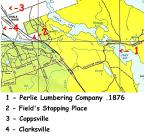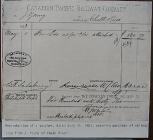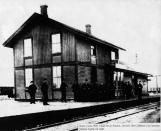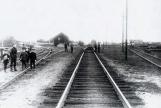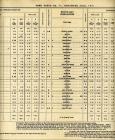1
The RailwayThe Canadian Pacific Railway was finally destined to run up through the area of Coppsville and Clarksville. A permanent depot, including a service shop and divisional point between Ottawa and North Bay was established. This divisional point was set up 1and 1/4 miles (2 Km) West of the original "Chalk River" and was also named Chalk River Divisional Point around the year 1880.
There were apparently three reasons why the C.P.R. chose the Chalk River site for it's divisional depot. The flatness of the land , the proximity of the site to a suitable source of boiler water, and the halfway mileage between Ottawa and North Bay
The land would require minimal preparation for construction of the yards and buildings and was close enough to Black Duck Lake so that it's water could be tapped with a minimal amount of piping. The quality of this water source was also an important determination in selecting this site. the corrosion content of this lake, salt and what not was comparatively low and would not cause as rapid rusting of the boiler tubes as other water sources, that is , to metal of those days. Later years produced metals to cope with such deficiencies as may have been troublesome in those times.
The water was drawn through a pumping station which was situated off Black Duck Lake on as some called it Pump House Creek, later known as Reckzine Creek. This pumping station was located between Hwy 17 and Ottawa Street. The steam driven pumps at this station rerouted the creek water to a high head storage tank which was built across from the station, not far from the Village's current storage tank. A reservoir or second head tank was also built nearby the pumping station. These old tanks , unlike the steel reservoir which stands today, were built of wood.
The original C.P.R. station, built in 1880 was located about 200 yards east , and on the same side of the tracks as the existing station. This structure served as the local freight shed in later years , after a new railway depot was constructed in 1910 -11, and continued to serve this function until a new freight shed was raised on the north east side of the tracks in 1953. The old shed outlived it's usefulness and was dismantled around 1958. The freight shed was not alone in its obsolescence, what began as a small service shop in the 1880's grew to be a rather sophisticated and up to date mechanic's shop in the 1930's only to be cut back in size and importance in the early 1970's . What was once the life's breath of the C.P.R. operations in the village was then drawing its last gasps of existence.
With more durable and automotive railway equipment which required fewer and fewer people to maintain and operate, coupled with a gradual loss of freightage to more efficient and cheaper means of transport, the C.P.R. staff was gradually cut to a skeleton staff.
3
The Canadian Pacific Railway was finally destined to run up through the area of Coppsville and Clarksville. A permanent depot, including a service shop and divisional point between Ottawa and North Bay was established. This divisional point was set up 1and 1/4 miles (2 Km) West of the original "Chalk River" and was also named Chalk River Divisional Point around the year 1880.5
Chalk River's importance is clearly indicated by it's appearance on this early 1900's map of Canada as the only settlement betwean Pembroke and Mattawa.7
This C.P.R. Voucher for $560.71 dated July 11, 1883 covers the purchase of railway ties from J. Young of Chalk River.9
The first CPR Station in Chalk River11
(Audio Text - CLAIR DAGG)Q; Where did these come from and were they destined for Chalk River?
A; Oh no, that's all moving stock, from Montreal to Vancouver going west and from Vancouver going East. See it was "an away from home" terminal for North Bay crews and for Smiths Falls crews. The crews from North Bay brought the stuff from North Bay and then they went in the Bunkhouse until it was their turn to go back. Then all this stuff had to be to an extent sorted. Like if the train came in from the west and he had local cars on, by local I mean Pembroke, Renfrew, Arnprior, They had to be switched out and put on the front of his train so that when he came to Pembroke the cars that he was setting off were next to his engine. They call that "Marshalling", so trains in both directions had to be "Marshalled"
13
A group of children standing at the crossing in Chalk River. The man on the right with white sleeves is Bill Cuthbert. On the left one can see two buildings, The Superintendant's house, and a sleep camp for perminant section men, next right, the freight shed , and in the centre background, the first Station. The building on the extreme right has been identified as what was called the bunkhouse for rail gangs.(Information from Schoolhouse Museum Archives) about 1900.
(audio text)
Q. Was there one person in charge of the operation?
A. No, they had a Locomotive Foreman who looked after all "Power", like, all the engines. And then they had a "Car Foreman", he looked after all the rolling stock for repairs, like box cars, and flat cars, whatever needed to be repaired in the rolling stock. That was the "Car Foreman", and then they had a "Yard Foreman" who looked after all the switching and all the moving of the cars, that was my job, I was the foreman there for 29 years.
